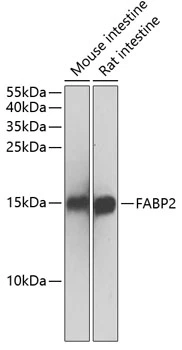![FABP2 (Marker of Metastatic Potential in Colorectal Cancer)(CPTC-FABP2-3), CF640R conjugate, 0.1mg/mL [26628-22-8] FABP2 (Marker of Metastatic Potential in Colorectal Cancer)(CPTC-FABP2-3), CF640R conjugate, 0.1mg/mL [26628-22-8]](https://biotium.com/wp-content/uploads/2016/12/placeholder.png)
FABP2 (Marker of Metastatic Potential in Colorectal Cancer)(CPTC-FABP2-3), CF640R conjugate, 0.1mg/mL [26628-22-8]
BNC402226
TargetFABP2
Product group Antibodies
Overview
- SupplierBiotium
- Product NameFABP2 (Marker of Metastatic Potential in Colorectal Cancer)(CPTC-FABP2-3), CF640R conjugate, 0.1mg/mL [26628-22-8]
- Delivery Days Customer9
- CertificationResearch Use Only
- ClonalityMonoclonal
- Clone IDCPTC-FABP2-3
- Concentration0.1 mg/ml
- ConjugateOther Conjugate
- Gene ID2169
- Target nameFABP2
- Target descriptionfatty acid binding protein 2
- Target synonymsFABPI, I-FABP, fatty acid-binding protein, intestinal, fatty acid binding protein 2, intestinal, intestinal-type fatty acid-binding protein
- HostMouse
- IsotypeIgG1
- Protein IDP12104
- Protein NameFatty acid-binding protein, intestinal
- Scientific DescriptionThe intracellular fatty acid-binding proteins (FABPs) belong to a multigene family with nearly twenty identified members. FABPs are divided into at least three distinct types, namely the hepatic-, intestinal- and cardiac-type. They form 14-15 kDa proteins and are thought to participate in the uptake, intracellular metabolism and/or transport of long-chain fatty acids. They may also be responsible in the modulation of cell growth and proliferation. Intestinal fatty acid-binding protein 2 gene contains four exons and is an abundant cytosolic protein in small intestine epithelial cells. This gene has a polymorphism at codon 54 that identified an alanine-encoding allele and a threonine-encoding allele. Thr-54 protein is associated with increased fat oxidation and insulin resistance. Primary antibodies are available purified, or with a selection of fluorescent CF® Dyes and other labels. CF® Dyes offer exceptional brightness and photostability. Note: Conjugates of blue fluorescent dyes like CF®405S and CF®405M are not recommended for detecting low abundance targets, because blue dyes have lower fluorescence and can give higher non-specific background than other dye colors.
- SourceAnimal
- Storage Instruction2°C to 8°C
- UNSPSC12352203







